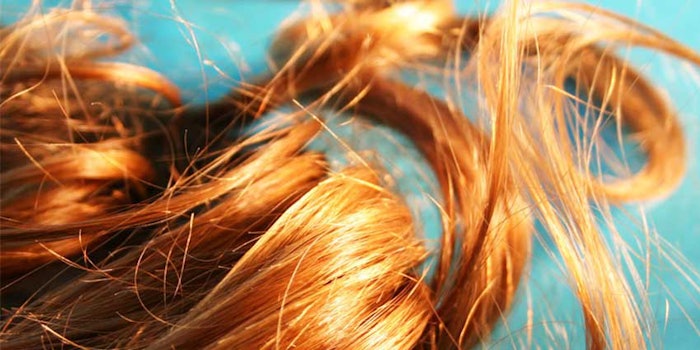
Few attributes are more intrinsically linked to consumers’ perception of healthy hair than shine. Healthy hair appears glossy and vibrant; damaged hair is typically dull and lifeless. These perceptions lead marketers to craft product communication messages and claims pertaining to this desirable property—which subsequently dictates the need for an appropriate measurement technique.
From a technical perspective, however, this is still a somewhat nebulous and contentious topic, which is nowhere near as clean cut as other evaluation methods. This situation does not arise from any lack of attention in scientific literature, as a considerable number of relevant historical articles are available. We attempt to technically quantify hair shine while discussing the relevance of results to consumer perception of this property.
Technically Speaking: Shine
From a purely technical viewpoint, shine constitutes the ability for light to reflect off of surfaces. Light rays bouncing cleanly off a surface at a 90o angle to the incident light are termed specular reflection. Light rays scattered to some extent—and thus reach a detector at other angles—are deemed diffuse reflection. Figure 1 shows a schematic illustrating different potential pathways for the interaction of light with single hair fibers.
Pathway 1 depicts specular reflection, while all others represent forms of diffuse reflection. Changes in the condition and integrity of the hair’s outer cuticle surface will clearly influence its interaction with light.
For example, a degrading cuticle structure, illustrated by Pathway 4, will increase scattering of light (i.e. diffuse reflection) at the expense of the clean, specular reflection. Similarly, the presence of exogenous soils on the hair surface, including sebum, product residue, etc., can also curtail specular reflection, as seen by Pathway 5.
Therefore, attempts at quantifying technical hair shine typically comprise mathematical relationships involving ratios of specular (S) and diffuse (D) reflection reaching a detector. Below is a selection of equations proposed in the scientific literature for placing numeric values on hair shine.
There is no shortage of ways to numerically describe “technical shine,” although complications arise due to variation in equation selection and because of considerable contributions from certain experimental variables. However, before exploring these issues, it is necessary to look at how such measures can be performed.
Measurement Approaches
Initial attempts to assess technical hair shine involved use of a goniophotometer to monitor light reflecting off the surface of single fibers.2-5 This is clearly a fundamental approach wherein the negative effects of cuticle damage and/or the presence of exogenous soils can be arithmetically represented. However, any suggestion that the magnitude of these changes is linearly equated to the consumer perception of hair shine appears tenuous at best.
Instead, the conclusion that consumer perception of shine is a whole-head property, which relates to how light interacts with an array of hair fibers as opposed to single fibers, is instinctive.
The so-called polarized light approach is an alternative method, which investigates reflection of light on hair tresses, anchored over a cylindrical sample holder6-9 (see Figure 2). This measurement process involves capturing two images of light reflecting off of the hair array surface.
The first is performed with polarizing filters mounted in a parallel configuration, which allows for evaluation of the total reflected light (S + D). A second utilizes perpendicular polarized filters, eliminating specular reflection and capturing only diffuse reflection (D). The subsequent subtraction of one image from the other then yields the specular reflection (S), and these two parameters can then be used to provide quantification. This approach attained a spike in popularity during the middle- to late-2000s as a commercial instrument hit the market.
Complicating Factors
Commercially-available shine serums are generally a mixture of volatile silicone oil and some non-volatile oils. From a technical perspective, the oils smooth out surface asperities, facilitating specular reflection. With time, evaporation of volatile silicone leads to a gradual decrease in the amount of this coating.
Figure 3, Figure 4 and Figure 5 show results from the polarized light approach, where a commercial shine serum was applied to medium brown hair at a 5% dosage. Figure 3 shows results when the acquired reflection data was treated in accordance with the Reich-Robbins equation. After immediate application, results suggest an approximate 80% increase in technical shine. However, this benefit is lost over time as volatilization of the oil returns this parameter to the original level.
Figure 4 shows the result of inputting the exact same reflection data into the TRI equation. Results suggest an approximate 30% increase in technical shine, but after 24 hours, data reveals the hair becomes about 10% duller than the initial state.
Finally, Figure 5 shows the result of inputting the same data to the Stamm equation. This time, results indicate only a 5% increase in technical shine, but with a significant benefit still being present after 24 hours.
Note these conflicting conclusions are obtained from the exact same specular and diffuse reflection data—the only variable being the equation itself. Clearly, this is a rather disquieting situation.
Hair color also has a huge impact on the magnitude of technical shine results. Less-pigmented hair has a stronger likelihood of light penetrating into fibers, where it can subsequently be scattered or reflected in different ways (Pathways 2 and 3 in Figure 1). Accordingly, the ratio of specular to diffuse reflection decreases and technical shine is reduced. Figure 6 shows experimental data illustrating this point.
The high shine commonly associated with heavily pigmented Asian hair is often cited as consumer-relevant support of this conclusion. However, the reverse argument implies blondes are inherently predisposed to not being able to have shiny hair, which does not appear to ring true.
Getting Aligned
Hair alignment is a key component of shine and other properties of the hair, yet its importance is rarely discussed and not often measured.10 Highly aligned hair, moving in a fluid and flowing motion, is more manageable and is devoid of frizz. Furthermore, it also provides a flatter, more-uniform hair array surface for reflecting light.
Figure 7 shows results from the polarized light approach wherein technical shine of hair was assessed before and after heat straightening with a commercial iron. The heat-straightened hair looks visibly shinier; this observation is manifested in the technical data.
An argument could be made of the high heat and friction associated with these treatments would damage the hair surface, diminishing shine. This argument is probably partially true; a decrease in single-fiber shine might be expected, but the very high degree of fiber alignment provides an overriding effect, ultimately leading to an overall increase in the shine of a hair array.
As I mentioned, the high shine of heavily pigmented Asian hair is often suggested to reinforce the correlation between hair color and technical shine. However, very straight styles are popular and commonplace in these cultures. Therefore, the high degree of fiber alignment would seem to be a significant contributor in this occurrence. This point also provides a possible explanation of how sleek, straight blonde hair can appear “shiny.” Of course, the argument also illustrates the limitation of the polarized light approach because measurements are performed with hair tresses anchored in an artificially aligned state (Figure 2).
Making Shine Claims
Consumers perceive improved shine as the result of using a variety of hair care products; but the underlying mechanism for this benefit is product-form dependent—and so evaluation of different products requires different experiments.
Conventional shine serums are straightforward in that oil coatings smooth out hair surface asperities to yield higher reflection (Figure 3, Figure 4 and Figure 5), but comparable effects should not be expected from conventional shampoo and conditioner products. Build-up of surface deposits leads to a decrease in the technical shine of hair (Pathway 5 in Figure 1), so it appears reasonable to conclude shampoos inherently provide shine benefit by removing these dulling deposits.
A simple series of lab experiments substantiates this claim. By establishing a baseline shine of clean hair, we can show the negative effects of applying an artificial sebum concoction11 or a heavily depositing product regimen. A shampoo wash restores the initial state.
The same rationale leads to a potentially conflicting conclusion regarding conventional conditioner treatments, which deposit waxy, lubricating materials on the hair surface. Consequently, these coatings may be expected to dull hair; although consumers generally perceive conditioners as beneficial in terms of improving shine.
A seemingly logical explanation involves the ability of conditioners to facilitate manageability and by doing so aid in the ability to induce hair fiber alignment. Compensating for this, a modified version of the tress holding device shown in Figure 2 was designed where hair is combed into place. This approach generally shows statistically significant shine benefits being associated with traditional conditioner treatments—although the magnitude of these changes is not especially sizable.
Summary
From a technical perspective, it is possible to measure the ability for light to reflect off the surface of individual hair fibers and hair arrays. However, some issues regarding the relevance of these numbers to the consumer perception of shine still need to be resolved. Undoubtedly, instances arise where the numbers alter in accordance with expectations, such as hair surface integrity and cleanliness.
Conversely, notable disconnects exist with the ways consumers discuss their hair’s properties. Consequently, the evaluation methods used here have constantly been referred to as appraising technical shine. Similarly, perhaps historical articles focusing on the complex physics associated with the interaction of light and the hair surface have tended to use non-consumer terms such as luster, radiance or gloss.
Prior to the mid-2000s and the introduction of commercial equipment, few laboratories had the capability to build their own goniophotometers and/or polarized light equipment. Accordingly, the availability of this new instrumentation was met with widespread and rapid acceptance as it seemingly provided a ready means of validating marketing propositions and establishing popular quantitative claims.
The polarized light approach can be used to demonstrate improved light reflection on hair arrays as a result of certain product treatments, although different experiments are needed for different product forms. However, very different conclusions can be attained by treating the exact same reflection data with various equations from the scientific literature. The hair color can also have a strikingly dominant effect on technical shine.
I propose hair fiber alignment is the missing variable from traditional discussions on hair shine. Clearly, this consideration is totally absent from single fiber experiments: while its contribution to the current version of the polarized light approach is not easily accessible due to hair mounting considerations. Nonetheless, light is able to reflect more-efficiently off a well-oriented array of fibers.
This suggestion is seemingly able to negate objectionable conclusions arising from current technical evaluation methods. For example, straight, sleek blonde hair can still appear very shiny and advantages in terms of the manageability associated with waxy conditioner deposits can override their otherwise seemingly dulling effect on individual fibers alone. Yet this idea does not necessarily negate shine in curly hair, where high alignment within individual curls can still allow considerable specular reflection.
It would seem our industry still has work ahead to properly characterize hair shine in a consumer-relevant manner.
References
- C. Reich and C. R. Robbins, “Light Scattering and Shine Measurements of Human Hair: A Sensitive Probe of the Hair Surface,” J Cos Sci, 44 (1993), 221-234.
- K. Keis, K.R. Ramaprasad and Y.K. Kamath, “Studies of Light Scattering from Ethnic Hair Fibers”, J Cos Sci, 55 (2004), 49-63.
- R.F. Stamm, M.L. Garcia and J.J. Fuchs, “The Optical Properties of Hair II: The Luster of Hair Fibers”, J Cos Sci, 28 (1977), 601-609.
- A. Guiolet, J.C. Garson and J.L. Levecque, “Study of the Optical Properties of Human Hair”, Int J Cos Sci, 9 (1987), 111-124.
- F.J.Wortmann, E.Schulze zur Wiesche and B.Bourceau, “Analyzing the laser-light reflection from human hairs. II. Deriving a measure of hair luster”, J Cos Sci, 55, (2004) 81-93.
- N.Lefaudeux, N.Lechocinski, P.Clemenceau and S.Breugnot, “New luster formula for the characterization of hair tresses using polarization imaging” J Cos Sci, 60, (2009) 153-169.
- H.K. Bustard & R.W. Smith, “Investigation into the scattering of light by human hair”, Appl Optics, 30, (1991), 3485-3491.
- R.McMullen and J,Jachowicz, “Optical properties of hair: Effect of treatments on hair luster as quantified by image analysis, J Cos Sci, 54, (2003), 335-351
- R.McMullen and J.Jachowicz, “Optical properties of hair: Detailed examination of specular reflection patterns in various hair types, J Cos Sci, 55, (2003), 29-47
- T.A.Evans, “Defining and Controlling Frizz, Cosm & Toil, 130(4), (2015), 46-53.
- Synthetic sebum










